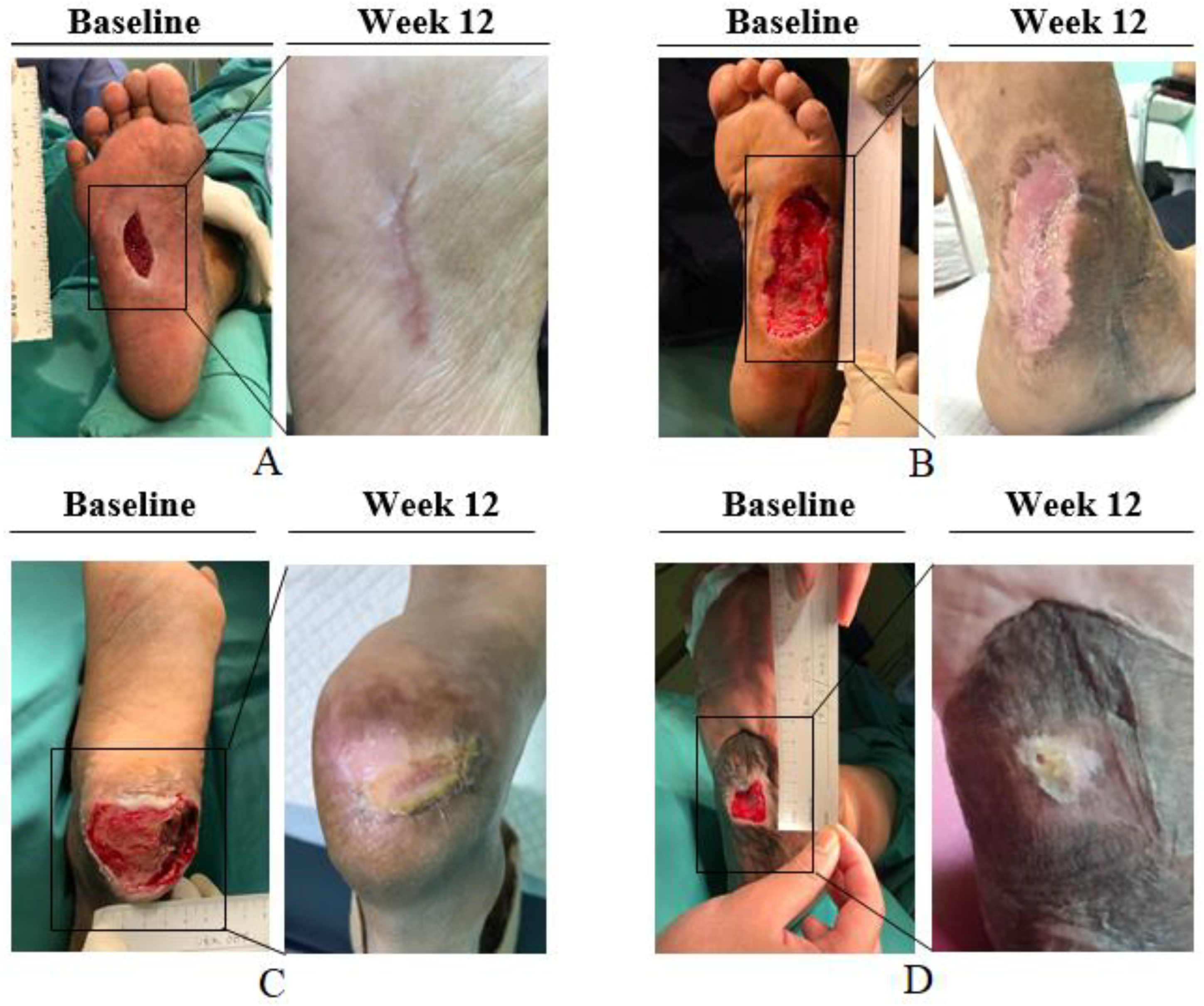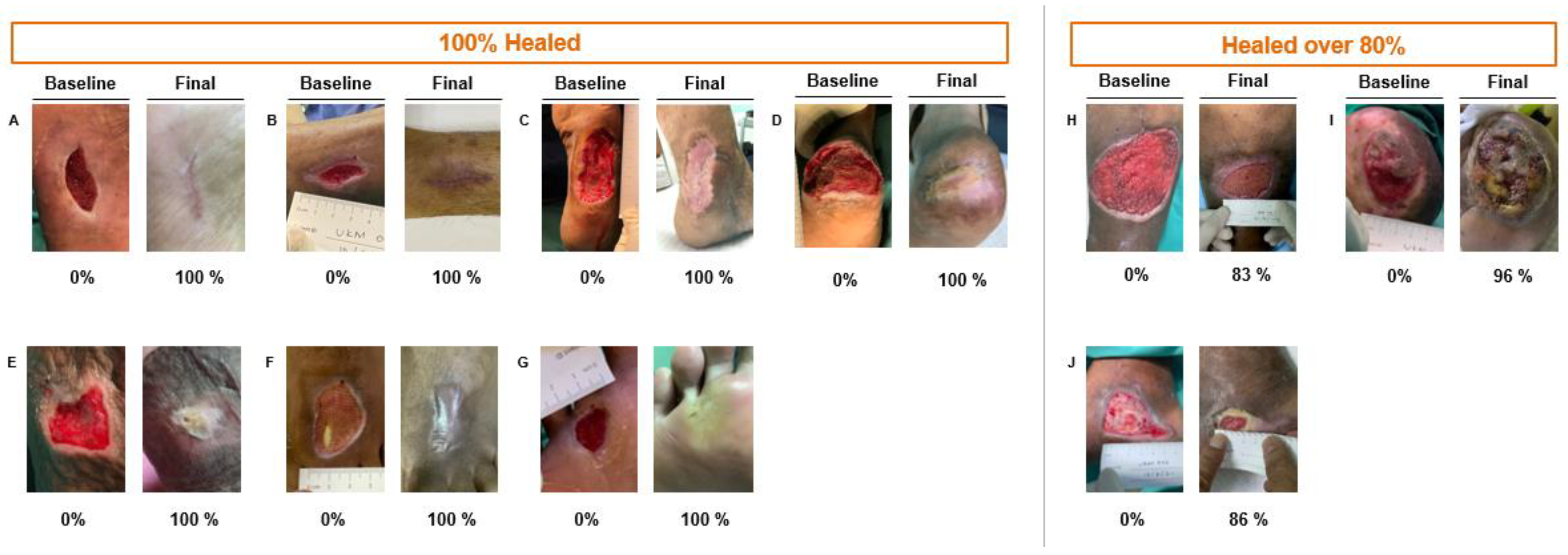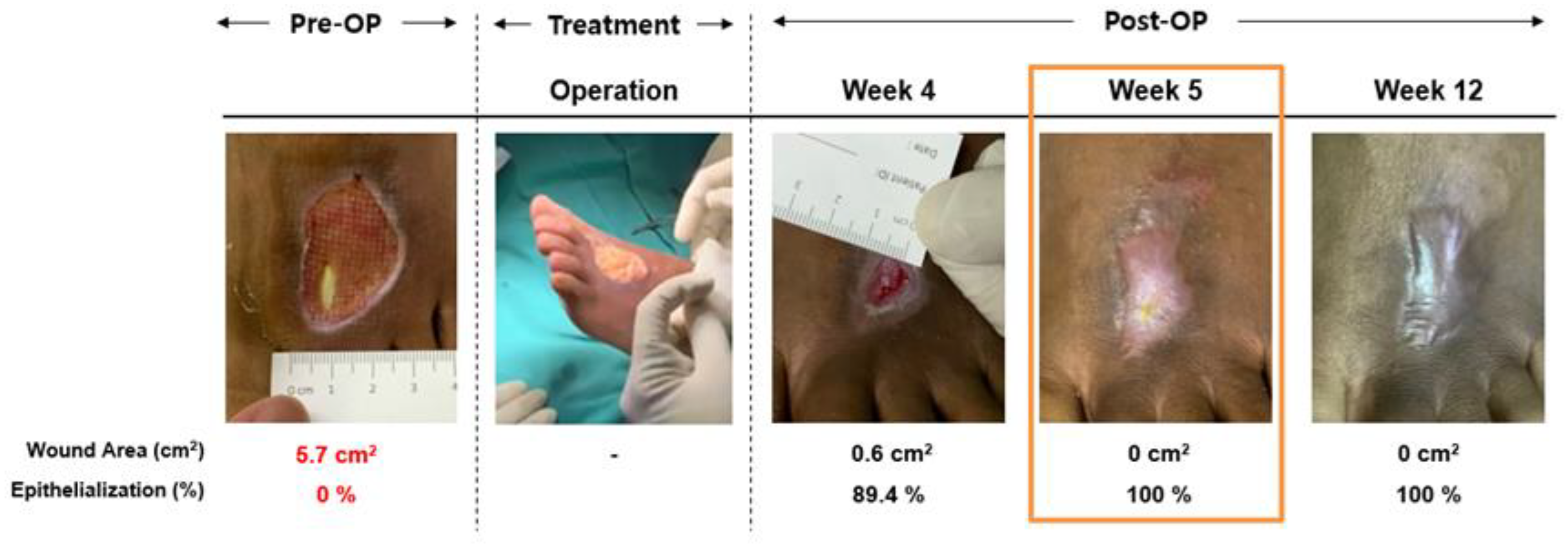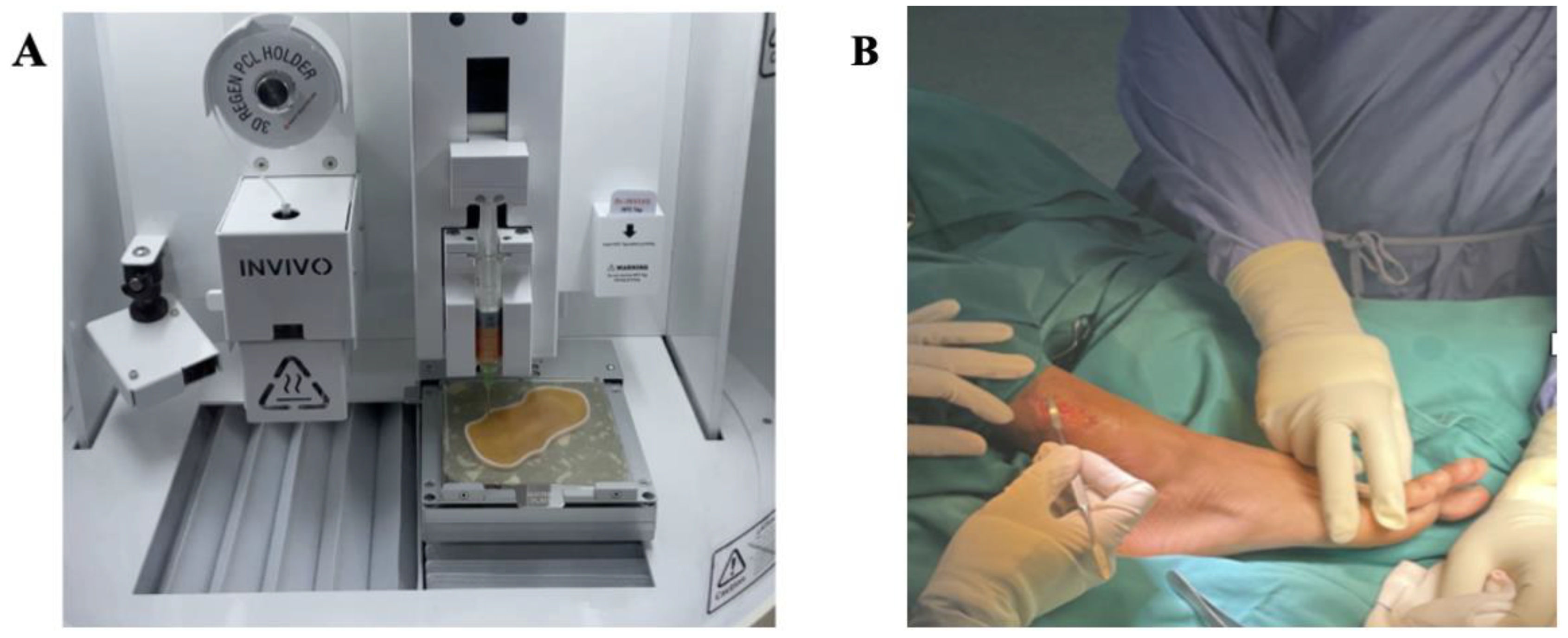New Paradigm in Diabetic Foot Ulcer Grafting Techniques Using 3D-Bioprinted Autologous Minimally Manipulated Homologous Adipose Tissue (3D-AMHAT) with Fibrin Gel Acting as a Biodegradable Scaffold
Abstract
1. Introduction
2. Results
2.1. Participants
2.2. Complete Epithelialisation of the Wound
2.3. Wound Area Reduction
2.4. Time to Healing
2.5. Discussion
3. Conclusions
4. Materials and Methods
4.1. Study Design
4.2. Participants
4.3. Inclusion Criteria
4.4. Exclusion Criteria
4.5. Intervention
4.6. Follow-Up
4.7. Outcome Measures and Data Analysis
Author Contributions
Funding
Institutional Review Board Statement
Informed Consent Statement
Data Availability Statement
Conflicts of Interest
References
- IDF. Diabetes Facts & Figures. Available online: https://idf.org/aboutdiabetes/what-is-diabetes/facts-figures.html (accessed on 12 February 2021).
- Pourkazemi, A.; Ghanbari, A.; Khojamli, M.; Balo, H.; Hemmati, H.; Jafaryparvar, Z.; Motamed, B. Diabetic foot care: Knowledge and practice. BMC Endocr. Disord. 2020, 20, 2020. [Google Scholar] [CrossRef] [PubMed]
- Everett, E.; Mathioudakis, N. Update on management of diabetic foot ulcers. Ann. N. Y. Acad. Sci. 2018, 1411, 153–165. [Google Scholar] [CrossRef] [PubMed]
- Perez-Favila, A.; Martinez-Fierro, M.L.; Rodriguez-Lazalde, J.G.; Cid-Baez, M.A.; Zamudio-Osuna, M.d.J.; Martinez-Blanco, M.d.R.; Mollinedo-Montaño, F.E.; Rodriguez-Sanchez, I.P.; Castañeda-Miranda, R.; Garza-Veloz, I. Current therapeutic strategies in diabetic foot ulcers. Medicina 2019, 55, 714. [Google Scholar] [CrossRef] [PubMed]
- Mojallal, A.; Lequeux, C.; Shipkov, C.; Breton, P.; Foyatier, J.-L.; Braye, F.; Damour, O. Improvement of skin quality after fat grafting: Clinical observation and an animal study. Plast. Reconstr. Surg. 2009, 124, 765–774. [Google Scholar] [CrossRef] [PubMed]
- Chopinaud, M.; Labbé, D.; Creveuil, C.; Marc, M.; Bénateau, H.; Mourgeon, B.; Chopinaud, E.; Veyssière, A.; Dompmartin, A. Autologous adipose tissue graft to treat hypertensive leg ulcer: A pilot study. Dermatology 2017, 233, 234–241. [Google Scholar] [CrossRef] [PubMed]
- Lonardi, R.; Leone, N.; Gennai, S.; Borsari, G.T.; Covic, T.; Silingardi, R. Autologous micro-fragmented adipose tissue for the treatment of diabetic foot minor amputations: A randomized controlled single-center clinical trial (MiFrAADiF). Stem Cell Res. Ther. 2019, 10, 223. [Google Scholar] [CrossRef] [PubMed]
- Smandri, A.; Nordin, A.; Hwei, N.M.; Chin, K.-Y.; Abd Aziz, I.; Fauzi, M.B. Natural 3D-printed bioinks for skin regeneration and wound healing: A systematic review. Polymers 2020, 12, 1782. [Google Scholar] [CrossRef] [PubMed]
- Goh, T.C.; Bajuri, M.Y.; Nadarajah, S.C.; Rashid, A.H.A.; Baharuddin, S.; Zamri, K.S. Clinical and bacteriological profile of diabetic foot infections in a tertiary care. J. Foot Ankle Res. 2020, 13, 36. [Google Scholar] [CrossRef]
- Murphy, S.V.; Atala, A. 3D bioprinting of tissues and organs. Nat. Biotechnol. 2014, 32, 773–785. [Google Scholar] [CrossRef]
- Kantaros, A. 3D Printing in Regenerative Medicine: Technologies and Resources Utilized. Int. J. Mol. Sci. 2022, 23, 14621. [Google Scholar] [CrossRef]
- Coradin, T.; Wang, K.; Law, T.; Trichet, L. Type I Collagen-Fibrin Mixed Hydrogels: Preparation, Properties and Biomedical Applications. Gels 2020, 6, 36. [Google Scholar] [CrossRef] [PubMed]
- Li, Y.; Meng, H.; Liu, Y.; Lee, B.P. Fibrin gel as an injectable biodegradable scaffold and cell carrier for tissue engineering. Sci. World J. 2015, 2015, 685690. [Google Scholar] [CrossRef] [PubMed]
- Patty, D.J.; Nugraheni, A.D.; Dewi Ana, I.; Yusuf, Y. Mechanical Characteristics and Bioactivity of Nanocomposite Hydroxyapatite/Collagen Coated Titanium for Bone Tissue Engineering. Bioengineering 2022, 9, 784. [Google Scholar] [CrossRef]
- Thiruselvam, T.; Che-Ahmad, A.; Wong, P.F.; Hamid, A.H.A.; Hasan, M.I.; Bajuri, M.Y.; Singh, G.S.S.; Mala Valayatham, V.; Majid, S.N.A.; Tajri, H.M.; et al. Malaysian clinical practice guidelines for management of diabetic foot: A synopsis for the primary care physician. Malays. Fam. Physician 2021, 16, 103–113. [Google Scholar] [CrossRef]
- Smith-Strøm, H.; Iversen, M.; Igland, J.; Østbye, T.; Graue, M.; Skeie, S.; Wu, B.; Rokne, B. Severity and duration of diabetic foot ulcer (DFU) before seeking care as predictors of healing time: A retrospective cohort study. PLoS ONE 2017, 12, e0177176. [Google Scholar] [CrossRef] [PubMed]
- Mohd Yazid, B.; Ayeshya, A.; Nurhanani, A.B.; Mohd Rohaizat, H. The physiological, biochemical and quality of life changes in chronic diabetic foot ulcer after hyperbaric oxygen therapy. Med. Health 2017, 12, 210–219. [Google Scholar]
- Hisamuddin, N.; Zahiruddin, W.M.; Yazid, M.; Rahmah, S. Use of hyperbaric oxygen therapy (Hbot) in chronic diabetic wound-a randomised trial. Med. J. Malays. 2019, 74, 418–424. [Google Scholar]
- Abdullah, R.; Bajuri, M.Y.; Sharoni, S.K.A.; Panduragan, S.L. The effects of diabetic footcare programme towards quality of life among Type II diabetes mellitus patients in UKM Medical Centre (UKMMC). Malays. J. Med. Health Sci. 2021, 17, 181–188. [Google Scholar]
- Shirakami, E.; Yamakawa, S.; Hayashida, K. Strategies to prevent hypertrophic scar formation: A review of therapeutic interventions based on molecular evidence. Burn. Trauma 2020, 8, tkz003. [Google Scholar] [CrossRef]
- Chen, L.; Wang, Z.-C.; Ma, J.-J.; Sun, W.-J.; Wang, S.-W.; Gu, Z.-C.; Yang, X. Autologous nanofat transplantation accelerates foot wound healing in diabetic rats. Regen. Med. 2019, 14, 231–241. [Google Scholar] [CrossRef]
- Savoji, H.; Godau, B.; Hassani, M.S.; Akbari, M. Skin tissue substitutes and biomaterial risk assessment and testing. Front. Bioeng. Biotechnol. 2018, 6, 86. [Google Scholar] [CrossRef] [PubMed]





| Total Number of Patients (n) | 10 |
|---|---|
| Age in years (mean ± SD) | 48.7 ± 14.9 |
| Gender | Number of patients (%) |
| Male | 7 (70%) |
| Female | 3 (30%) |
| Presence of comorbidities | Number of patients (%) |
| 1 comorbidity | 4 (40%) |
| >1 comorbidities | 6 (60%) |
| Types of comorbidities | Number of patients (n) |
| Type II diabetes mellitus | 9 |
| Hypertension | 5 |
| Dyslipidaemia | 2 |
| Spondylodiscitis | 1 |
| End-stage renal failure (ESRF) | 1 |
| Ankle–Brachial Pressure Index (ABPI) (mean ± SD) | 1.11 ± 0.24 |
| Baseline ulcer size at week 0 in area (cm2) (mean ± SD) | 27.00 ± 43.99 |
Disclaimer/Publisher’s Note: The statements, opinions and data contained in all publications are solely those of the individual author(s) and contributor(s) and not of MDPI and/or the editor(s). MDPI and/or the editor(s) disclaim responsibility for any injury to people or property resulting from any ideas, methods, instructions or products referred to in the content. |
© 2023 by the authors. Licensee MDPI, Basel, Switzerland. This article is an open access article distributed under the terms and conditions of the Creative Commons Attribution (CC BY) license (https://creativecommons.org/licenses/by/4.0/).
Share and Cite
Bajuri, M.Y.; Kim, J.; Yu, Y.; Shahul Hameed, M.S. New Paradigm in Diabetic Foot Ulcer Grafting Techniques Using 3D-Bioprinted Autologous Minimally Manipulated Homologous Adipose Tissue (3D-AMHAT) with Fibrin Gel Acting as a Biodegradable Scaffold. Gels 2023, 9, 66. https://doi.org/10.3390/gels9010066
Bajuri MY, Kim J, Yu Y, Shahul Hameed MS. New Paradigm in Diabetic Foot Ulcer Grafting Techniques Using 3D-Bioprinted Autologous Minimally Manipulated Homologous Adipose Tissue (3D-AMHAT) with Fibrin Gel Acting as a Biodegradable Scaffold. Gels. 2023; 9(1):66. https://doi.org/10.3390/gels9010066
Chicago/Turabian StyleBajuri, Mohd Yazid, Jeehee Kim, Yeongseo Yu, and Muhammad Shazwan Shahul Hameed. 2023. "New Paradigm in Diabetic Foot Ulcer Grafting Techniques Using 3D-Bioprinted Autologous Minimally Manipulated Homologous Adipose Tissue (3D-AMHAT) with Fibrin Gel Acting as a Biodegradable Scaffold" Gels 9, no. 1: 66. https://doi.org/10.3390/gels9010066
APA StyleBajuri, M. Y., Kim, J., Yu, Y., & Shahul Hameed, M. S. (2023). New Paradigm in Diabetic Foot Ulcer Grafting Techniques Using 3D-Bioprinted Autologous Minimally Manipulated Homologous Adipose Tissue (3D-AMHAT) with Fibrin Gel Acting as a Biodegradable Scaffold. Gels, 9(1), 66. https://doi.org/10.3390/gels9010066





